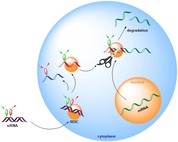New therapeutic options for targeted cancer treatment at source and thereby reducing or better avoiding side-effects are of extraordinary importance. One method for this is to take the advantage of a gene regulation mechanism of our body, the so called RNA interference.
In this pathway, a short, double stranded RNA (siRNA) is unwound into two single stranded RNAs by an enzyme complex (RISC). One single stranded RNA (sense strand) is removed, while the other one (antisense strand) remains associated. The antisense strand hybridizes with the complementary target mRNA (e.g. oncogene) which is afterwards degraded by an enzyme component (Argonaut) of the RISC. As a result, the encoded proteins can not be expressed anymore.
This mechanism as well as the uptake and degradation of the single stranded RNA inside the cell have to be investigated in detail before developing effective drugs. Therefore, we modify double stranded RNA with a fluorescent dye pair, which undergo an energy transfer. Upon excitation of the donor dye (green) the energy is transferred to the acceptor dye (red) resulting in a fluorescent colour change. Hence, it is possible to track the mechanism and to determine the location inside the cell.




